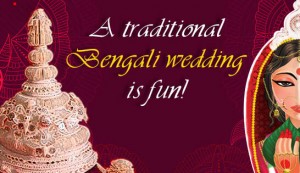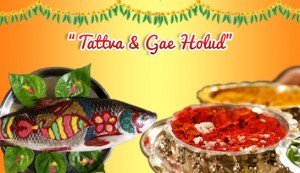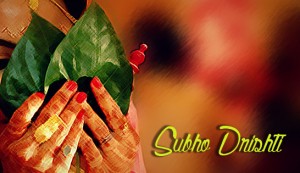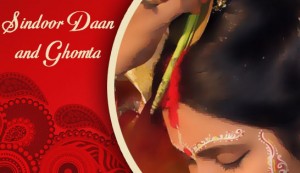Bengali Wedding Rituals: Tradition Coupled with Fun

Those of you who have had the good fortune of witnessing a Bengali wedding from the start to the end would surely agree that it is a visual delight. Bengali Hindu weddings like most other Indian weddings are a blend of traditional customs and rituals with a touch of modernity.
These weddings are full of color and vivacity. Also a marriage leads to reunion of family members and old friends. New relations are made and old ones get further strengthened. In a way, a marriage signifies the beginning of a new journey not just for the couple but for the entire clan.
Bengali weddings usually are not opulent (although flashy or gaudy are probably more apt words!) but require elaborate preparations to perform the many rituals with precision. Sometimes it could also be physically demanding.
For hassle free planning and management of Bengali weddings, check out WedPlan.
Let me walk you through some of the common rituals and traditional ceremonies we see in Bengali weddings.
Pre-wedding rituals
Bengali wedding rituals start a few months prior to the actual wedding. Some of them might have become obsolete with passage of time while others are still meticulously followed.
The wedding rituals and customs followed by families hailing from different districts of West Bengal (Ghoti) and Bangladesh i.e. erstwhile East Bengal (Bangal) often vary to some degree.
Let us now turn our attention to the ceremonies.
Adan Pradan
There was a time when the families would converge at a place with priests to fix the auspicious marriage date from an almanac after the bride and the groom have given their consent for the marriage and their horoscopes have been matched. The families would then formalize the wedding and exchange gifts.
But it is an outdated practice today as match-making and even horoscope compatibility are checked online. The wedding dates are decided upon and communicated on the telephone.
Aashirvad
This is a ceremony where the bride and the groom are formally accepted by their respective in-laws and elders from the two families assemble to shower their blessings on the bride and the groom. They put husked rice and trefoil leaves on the head of the bride and the groom and present gold ornaments or other gifts as a token of their love. Sometimes it happens a few months before the actual wedding and sometimes on the day of the wedding itself.
Ai Budo Bhaat
This is pretty similar to the concept of bridal shower or bachelor party associated with Christian weddings. Usually friends, neighbors and close relatives assemble at the house of the bride or the groom on the day before the solemn marriage ceremony is to take place.
The bride and the groom in their respective homes are offered a platter of traditional Bengali delicacies as it is considered as the last meal as a spinster and a bachelor respectively. The assembled guests often sing and dance and make merry. Today, a lot of Bengali weddings have borrowed the concepts of Sangeet and Mehendi from North Indian weddings and merge them with Ai Budo Bhaat.
Dodhi Mangal
This is held at the dawn of the wedding day. The family members and close relatives of the bride/groom move in a procession to a nearby waterbody(preferably River Ganges) where they fill a pitcher with water and return. This water would later be used during the snan ritual.
The would-be couple is then fed curd, rice flakes, banana and sweets at their respective homes and they are expected to fast after this meal until their wedding is solemnized. Usually, the mother or an elderly married relative feeds the bride or the groom. People from some districts of the erstwhile East Bengal call this ceremony adhibas instead of dodhi mangal.
Nandi Mukh
This is a ritual which is performed on the morning of the wedding just before the ‘gaye holud’ ceremony of the bride or the groom. It is performed in the homes of both parties. A priest chants Vedic incantations and the extended family pays homage to their forefathers. A small puja is performed for the well being of the ancestors in the afterlife and also to ask for their blessings.
Tattva, Gae Holud and Snan

On the morning of the wedding, both the families dispatch gifts called tattva to the other. Members from the groom’s family bring a new saree to be worn by the bride during ‘gae holud’. They also bring oil, a big, decorated carp or rohu fish, personal grooming and toiletry products, sweetmeats and other edibles. A lot of attention is paid to the number and decoration of the ‘tattva’.
The turmeric paste which is applied on the body of the groom, in a ceremony called gae holud, is carried along with the tattva to the home of the bride and the same paste is then applied to her body. Then the water brought from the water body at the day break is used to bathe the bride. This is known as snan.
Sankha and Pola
In some Bengali weddings, the bride is made to wear conch shell bangles which are red and white in color on the day of ai budo bhaat while in others, the bride has to wear it on the morning of the wedding after or during the gae holud. The white ones are called sankha while the red ones are called pola. These bangles are similar in essence to ‘mangalsutra’ that North Indian married women wear.
Wedding Rituals
Bor Jatri and Bor Baran
Bengali Hindu weddings have a specific time frame which is considered most auspicious and the wedding ceremony takes place within that period. It is called the lagna. The wedding procession led by the groom leaves for the wedding venue usually in a luxury caravan which is dispatched by the family of the bride. This group is called the ‘bor jatri’. A car sent separately for the groom leads the caravan.
At the entrance of the venue, the mother of the bride and other elders of the family wait to receive the group. The mother, in some weddings, first washes the wheels of the car in which the groom arrives. Then she anoints the groom with tilak from the baran dala and does an aarti before welcoming him. The other guests are also received with a lot of warmth. They are then seated and served refreshments.
Potto Bostro
The groom arrives in traditional Bengali attire of pleated dhoti and kurta. But after he is seated at the chchadnatala which is basically the sanctum sanctorum of the mandap where the rites would be performed, an elderly member, usually the maternal uncle of the bride, who would later do the ‘kanya sampradan’, gifts the groom new clothes which he has to wear during the wedding rituals. These clothes are known as ‘potto bostro’. In Sylheti weddings, the canopy tent (Mandap) is given a special look. It is called kunja and looks beautiful.
Saat Paak (on pidi) and Subho Drishti

The bride enters the ‘mandap’ where the groom is already seated along with the priests. But the uniqueness of this ceremony lies in the fact that the bride seats on a wooden stool called a pidi. Her brothers and close male relatives then lift the bride seated on the pidi and carry her around the groom, who is seated in front of the wedding pyre, seven times in a row.
All along, the bride covers her eyes with a pair of betel leaves. Only after the saat paak is complete will the bride take the betel leaves off her eyes. Shortly afterwards, in the presence of the elders of the two families, the bride sets her eyes on those of the groom and their eyes meet amidst the blowing of conch shells and ululation. This is known as subho drishti.
Mala Badal
The subho dristi is followed by the ‘mala badal’. The bride still seated on the pidi and kept hoisted by the brothers, exchanges garlands made of fragrant flowers with the groom three times which signifies the couple’s acceptance of each other.
To add to the fun element, the brothers often try to hoist the bride as high as possible to make it difficult for the groom to reach the bride’s neck. When the going gets tough, enter the friends of the groom in the frame! They then try to lift the groom higher than the bride and competition between the two sides continue for a while and the assembled guests end up in peals of laughter.
Sampradan
An elderly member of the bride’s extended family hands over the bride to the groom.
Their hands are tied by a sacred thread and the hands will stay in bounds till the end of rituals. This ceremony is called sampradan or more specifically kanya sampradan.
Yagya and Saat Paak (on foot)
The Vedic rituals invoking the presence of Agnidev or Fire God to solemnize the marriage, is carried out by the priests. The would-be couple sits along with them and follow the instructions carefully.
After sometime, they are asked to go around the pyre seven times. The ‘uttariya’ worn by the groom and the end of the saree worn by the bride are tied in a knot called ‘gathbandhan’. The seven steps taken around the wedding pyre solemnizes the wedding. This is known as Saat Paak.
Anjali/Kusumdinge
In some weddings, the brother of the bride gives puffed rice or khoi in her hands and the couple then offer it to the holy fire.
However, in most weddings, the bride stands in front of the fire with a chaff in hand. The groom stands just behind her, their bodies touching and he then holds the hands of the bride. The khoi is put on the chaff and by using the concept of winnowing, the khoi is thrown into the fire. This is known as Kusumdinge.
In Sylheti Bengali weddings, the bride has to grind the khoi with a pestle, every time her brother hands over some quantity of khoi before offering it to the fire.
Sindoor Daan and Ghomta

The groom puts a vermilion mark on the forehead of the bride and also uses a new saree as a veil to cover her head.
This marks the end of the wedding rituals and the couple is declared man and wife.
Plan all ceremonies of the Bengali weddings easily with WedPlan.
Post wedding rituals
Basar Ghar
On the night of the wedding, after the guests have left, the couple and some young members of the extended family occupy a room and have fun. They chat non-stop, dance and sing. It is basically a time of merriment and joy. They also play different games. It is a process through which the couple as well as the others loosen up in the presence of one another.
Bashi Biye
On the morning after the wedding, another ritual called bashi biye is performed. The event is restricted only to the close relatives from both sides. A priest performs some pujas and invocations and it ends with a lunch.
Bidaay and Bodhu Baran
Bidaay is a touching ceremony where the bride leaves her family home with a heavy heart to move in with her in-laws. While departing, the bride keeps throwing fistfuls of rice backwards without looking back. This is how she tries to repay the debt of her family for bringing her up.
The newly-wed couple arrives in a car at the house of the groom where the mother stands at the doorway to receive them. The mother washes the car tyres and ushers the bride in. This is called bodhu baran. An imprint of her foot is taken on a white cloth using lac dye, red in color.
Some fun games are played by the bride and the groom, watched by onlookers made up of close friends, family and neighbors. They egg on the ‘competitors’ to win at all costs and clearly everything is done in jest. Also, the bride is shown around the house and is expected to acquaint herself with the assembled guests.
Kalratri
This is the first night that the bride spends at the home of her in-laws. The bride and the groom sleep in separate rooms on that night out of a belief borrowed from a fable or folklore that if the couple sleeps together on the first night, their conjugal life wouldn’t be harmonious.
Bou Bhaat and Reception
The following day, the bride has to cook some dishes and serve the food to the husband and other elders in the family. This is known as the bou-bhaat. The husband also hands over a saree and a plate of food to his wife and pledges to shoulder her responsibility for the rest of his mortal life. This ceremony is called bhaat kapor.
In the evening of that day or the next day, the family of the groom hosts a grand reception in honor of the new wife. Guests from the side of the groom come and join the gala dinner reception in an attempt to know the new member of the family.
Phool Shojja
On the second night of her stay in her husband’s home, the bride sleeps with the groom in a bed decked with flowers and wears floral ornaments. It is the night when the couple consummates their marriage.
SubhoChandi Satyanarayan Pujo
This is a puja offered to Lord Satyanarayan for the well being of the newly-wed couple and their families. A priest performs the Puja and then blesses the couple. This might either happen on the eighth day after marriage or even earlier.
Oshto Mangala
On the eighth day after the marriage, the couple returns back to the home of the bride. It is a day of jollity for the family and sometimes, people are invited also to partake of that happiness and the family makes arrangements for a lunch.
This marks the end of the wedding rituals under Bengali Hindu culture. Bengali marriages are beautiful yet laborious and time consuming. You might want to save as much time as possible for your family and guests rather than devoting your entire attention to the wedding arrangements.
Are you wondering if some tool is available to assist you in taking care of the logistics?
You are in luck. Check out a no-obligation demo of WedPlan at www.weddingplanning.in which offers end to end wedding planning software online for the entire team managing the wedding plan.